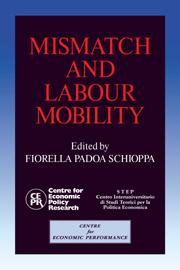Book contents
- Frontmatter
- Contents
- List of figures
- List of tables
- Preface
- Acknowledgements
- List of conference participants
- 1 A cross-country comparison of sectoral mismatch in the 1980s
- 2 Mismatch: a framework for thought
- Discussion
- 3 Match and mismatch on the German labour market
- Discussion
- 4 Mismatch in Japan
- Discussion
- 5 Mismatch and internal migration in Spain, 1962–86
- Discussion
- 6 Regional inequalities, migration and mismatch in Italy, 1960–86
- Discussion
- 7 Skill shortages and structural unemployment in Britain: a (mis)matching approach
- Discussion
- 8 Labour market tightness and the mismatch between demand and supply of less-educated young men in the United States in the 1980s
- Discussion
- 9 Skill mismatch, training systems and equilibrium unemployment: a comparative institutional analysis
- Discussion
- 10 Unemployment, vacancies and labour market programmes: Swedish evidence
- Discussion
- 11 Mismatch and labour mobility: some final remarks
- Index
8 - Labour market tightness and the mismatch between demand and supply of less-educated young men in the United States in the 1980s
Published online by Cambridge University Press: 05 October 2010
- Frontmatter
- Contents
- List of figures
- List of tables
- Preface
- Acknowledgements
- List of conference participants
- 1 A cross-country comparison of sectoral mismatch in the 1980s
- 2 Mismatch: a framework for thought
- Discussion
- 3 Match and mismatch on the German labour market
- Discussion
- 4 Mismatch in Japan
- Discussion
- 5 Mismatch and internal migration in Spain, 1962–86
- Discussion
- 6 Regional inequalities, migration and mismatch in Italy, 1960–86
- Discussion
- 7 Skill shortages and structural unemployment in Britain: a (mis)matching approach
- Discussion
- 8 Labour market tightness and the mismatch between demand and supply of less-educated young men in the United States in the 1980s
- Discussion
- 9 Skill mismatch, training systems and equilibrium unemployment: a comparative institutional analysis
- Discussion
- 10 Unemployment, vacancies and labour market programmes: Swedish evidence
- Discussion
- 11 Mismatch and labour mobility: some final remarks
- Index
Summary
One of the most disturbing economic developments of the 1980s in the United States was the deterioration in the real and relative earnings of less-educated male workers, particularly younger men (Murphy and Welch, 1990; Blackburn, Bloom and Freeman, 1990; Katz and Revenga, 1989; Bound and Johnson, 1989; Levy, 1988). In 1979 a male high school graduate aged 25–34 working year-round full-time earned $23,440 per year in 1987 dollars, 15% below the earnings of a comparably aged male college graduate. In 1987 the 25–34-year-old male high school graduate earned $21,420 per year – 9% less in real terms than in 1979, and 29% below the earnings of a 25–34-year-old college graduate. Declines of a similar magnitude occurred in the real and relative pay of young male high school dropouts. If one looks at workers with less than five years of work experience, moreover, the rise in the educational earnings differential is even greater: college men with less than five years' experience averaged 0.54 ln points more in weekly earnings than high school men with less than five years' experience in 1981–7 compared to 0.35 ln points more from 1974 to 1980. Among older less-educated men there were smaller but still noticeable drops in real and relative earnings. After decades in which the real wages of the less skilled trended upward, often rising more rapidly than the wages of the more skilled, the economy seemed to be on another course entirely, with a growing mismatch between the labour market demand and supply for skills.
- Type
- Chapter
- Information
- Mismatch and Labour Mobility , pp. 360 - 381Publisher: Cambridge University PressPrint publication year: 1991
- 3
- Cited by



